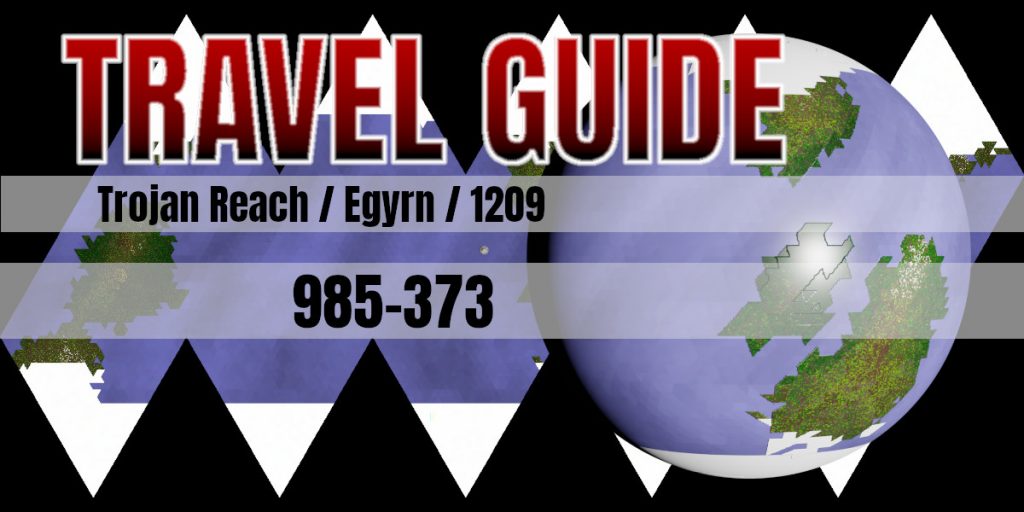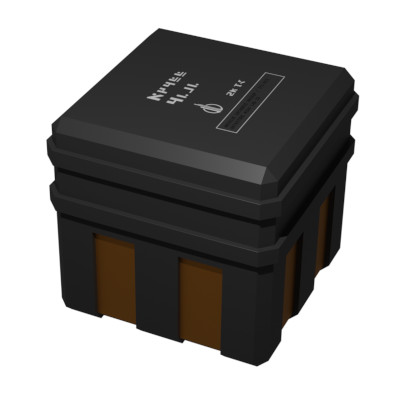985-373

985-373 is a red zone world in the Trojan Reach, the result of a nuclear and biological war which wiped out its population during the fall of the Sindalian Empire. From space, it is a lush garden world of green forests and blue seas, but animal life is limited, and deadly diseases still lie dormant in the soil, waiting for a suitable human host to set foot here again.
Fifteen centuries ago the world was known as Kaylor, and was a high technology world with a population of over five billion. As the Sindalian Empire fell into its final death throes, it was one of the many casualties. Rivalries between it and its neighbour Velscur came to a head, and there was an exchange of both nuclear and biological weapons between the two.
When it was rediscovered during the surveys of the Third Imperium, there was little sign of civilisation and it was designated 985-373. Closer investigation discovered a ring of orbital debris – the remains of a once extensive array of artificial satellites, as well as the empty ruins of a technological civilisation. No sign of sophonts was discovered though, and after several members of the scout team contracted fatal diseases it was decided to leave it alone and designate the entire world as a red zone.
Today, the world is pretty much left alone. The world is still orbited by a ring of dead communication satellites and weapon platforms – though pretty much anything of worth was scavenged centuries ago. Abandoned bases on the world’s moon have been left as tombs to the people who were left to die there after the supply ships stopped coming. Settlements across the rest of the system are similar – either abandoned or tombs to those that perished. Most have been stripped of useful supplies, a few spread their diseases to those that raided them.
The planet itself shows no sign of current civilisation. The night side is dark, and the radio bands are silent. Lush forest covers most of the continents, with only strange patterns in the canopies giving a hint of the ruins that lie beneath. Most of these ruins are the crumbled remains of concrete and steel, covered in centuries of growth that hides the corpses, vehicles and furnishings of a high tech civilisation.
Tangled red vines make up a lot of the undergrowth – thought to be some side effect of the bio weapons that ravaged the world all that time ago. There are no mammals on the continents – they were all targeted by the manufactured plagues and driven to extinction. With little to prey on them, birds have become the dominant species and many have lost their inclination to fly.
There are a few places where the skeletons of old cities still stand. Though fourteen centuries is long enough for most materials to fall into decay, the Grand Cathedral of City Four is a crystaliron structure that has withstood the tests of time. Once a government centre and administration building, its skeletal framework is over half a kilometre long and towers one hundred metres above the tree tops.
The “Blood Vines” have claimed the lower half of the structure, but the rest stands bare to the elements. This is not the only building that still stands, but is by the far the most impressive. Most of the other crystaliron structures are military bases or secure buildings – banks, research centres or the homes of the ultra rich. Most are small and obscured by vines or forest cover, a few, like the subterranean meson cannons are bases in the high mountains.
The world is classed as a red zone, with travel to it highly recommended against by the Imperium. However, there is nothing in place to stop anyone going there, and it’s not unheard of for traders to stop off on the world to refuel. There are several island chains in the southern Arkannos Ocean known as the Walrus Islands, due to the large number of walrus-like creatures that tend to live there. There are rocky beaches here which are considered safe for refuelling, and normally clear of animals due to the frigid winds that blows in from the west.
The major continents were hit hard with biological and nuclear warfare. The largest cities were destroyed in nuclear fireballs, whilst carefully manufactured plagues ravaged the countryside. From what records could be found from that period, it seems 90% of the population died within the first year, and 99% were dead within the first three years. After that point, all forms of civilisation had collapsed completely and records become almost non-existent.
It is thought that pockets of civilisation survived for up to a century, but populations of all major mammal species declined rapidly during this period. Only a few species, such as the Walruses of the southern oceans, survived through not being in contact with any of the major land masses.
Today, the ruined cities are little more than vegetation covered mounds of concrete, plastic and glass. Steel girders rusted away, and the bones of the victims have been subsumed into the earth. From space, a few roads can still be detected as slight variations in the forest, and the largest cities still appear as grid patterns.
Archaeological Interests
1,500 years is a long time, and even a large civilisation can mostly disappear in that time. Most of the buildings were built of brick or concrete, some with reinforced steel or wood making up part of them. Without continuous maintenance, leaks and cracks lead to wood rotting and steal rusting. The combination of wind and rain, plant growth and structural instability leads to concrete and brick work eventually crumbling.
Most buildings collapsed after a hundred years, a few lasted a few times that but after a thousand years even the largest cities were overgrown with green and roads had been subsumed beneath layers of earth and foliage. A close scan of the world can detect where the cities were, but there is little obvious from the air.
From the ground, crumbled walls may be visible beneath the plant life, but digging or deep scans are the best way to find out what used to be there.
Where more advanced materials such as crystaliron were used, buildings have lasted longer. Such construction techniques were only used on the most expensive or fortified buildings though. However, this often means that they were the most important buildings with the most interesting items inside.
Even average crystaliron buildings tend to last several centuries, with the most sturdy or lucky having lasted until this day. Of particular note are the meson silos of Basar Mountains and the Grand Cathedral of City Four (original name Xendosa). Though such buildings may be intact, their interiors will have still suffered considerable damage from water, animals and just general decay. Most rooms are filled with vegetation or may be the nests of birds or hives for a variety of insects.

A few archives of paper records have been recovered, but only where they were stored in special vaults which have themselves withstood the test of time. Most information had been stored on electronic medium, and in the great proportion of cases these have decayed to the point of uselessness. However, in a few cases Vilani memory cubes were used to store archival data, and these may be intact. Guaranteed to last a thousand years in good conditions, there are many examples which have lasted much longer than that. Their data capacities were low compared to Terran technologies, but constructed from resilient materials and with multiple layers of redundancy and built-in error correction, still readable examples have been found on many worlds, including 985-373. A testament to the Vilani’s desire for reliability and stability over technological progress.
So there are things to be found on 985-373, but its position in the Outrim Void has meant full scouting expeditions have been few and limited in scope.
Biological Interests
985-373 was hit by both nuclear and biological attacks. The former caused the most short term damage – destroying cities and shutting down supply lines. Over the years though the radiation has declined and now most of the ruins are safe, with only slightly elevated levels of radiation.
The biological plagues that ravaged the world though have had a lasting effect. Almost all mammal life was wiped out. Whether this was intentional, or just because diseases meant to target humans jumped the species barrier isn’t known. As far as the human population was concerned, it completely crashed, with all signs of any technological civilisation vanishing over a period of a few hundred years.
Viruses continued to mutate over this time, finding ways to lay dormant in the soil and then re-infect any new colonists that tried to make 985-373 their home. Eventually people stopped coming here. Though Aslan seemed more resistant to the plagues than humans, any attempt at colonisation by them also failed.
The world is still considered too dangerous for human habitation, though the chance of infection from a short stay is now considerably lower than it used to be. The diseases have mutated to allow them to exist in the local biosphere, with the original aims of human infection and death having become side effects.
Some of the local flora has adapted, mutating into the “Blood Vines” that seem to be prevalent in regions where large numbers of humans died, sometimes covering the ruined cities like a blanket. They have high concentrations of the viruses in them, and secrete a chemical containing them from their thorns. The vines are described as being ‘red’, but are almost dark enough to be black.
Officially the world has a population of zero, but there have been stories of humans of some kind living here. Called ghouls by those who claim to have seem them, they seem to be violent primitives who attack on sight. They seem to be infected by at least one strain of the viruses that are found here, but have evolved to live with it.
985-373 is at Egyrn Subsector, Trojan Reach 1209.
